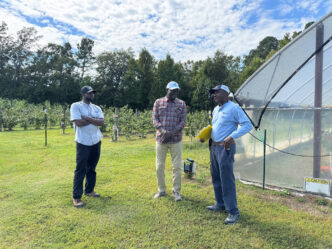
Millions of people face issues caused by malnutrition daily. While the word “malnutrition” might conjure up a visual of starvation, it actually does not mean “underfed.” A person can be obese and still be considered malnourished. But how?
Calorie-rich diets have played a critical role in creating this global phenomenon. Although individuals appear to be getting the food they need calorically they are still suffering from micronutrient malnutrition or “hidden hunger”.
“Malnutrition and obesity are health burdens the public needs to be aware of. By changing their food behaviors, they can have a great impact on their communities beyond just themselves,” said Clemson associate professor Dil Thavarajah.
She is responding to this crisis through scientific research and educational programs, working to find a solution.
Thavaraiah grew up eating lentils — a legume and form of pulse crop — three times a day. Pulse crops are plants harvested solely for the dry seed. Now, the familiar lentil is one of her primary research focus areas and something she knows can help combat malnutrition and obesity.
“I’ve really enjoyed looking at how lentils can impact obesity — and not only can they combat obesity, they can also combat hunger,” Thavarajah said. “They are full of micronutrients, protein and prebiotic carbohydrates, elements our body needs. Some of our preliminary studies indicate that regular lentil consumption positively changes the gut’s microbiome, increasing digestive heath and propelling the body’s functionality.”
In addition to combating hunger, Thavarajah’s expansive knowledge of pulse crop phenotyping — the process of predicting an organism’s characteristics using genetic information — has made her an internationally renowned leader in the field of biofortification. Each year, the strains of lentils grown changes due to yield and how the plants respond to diseases. In order to ensure breeders are using the best strain possible, they look to Thavarajah to identify the best collections for them to use.

“I am the person for all breeders around the world, and I’m very engaged with international breeding programs,” Thavarajah said. “If you can have a better variety released in the next five years with a high prebiotic carbohydrate that will further help combat these issues, and if I can work to educate the U.S. population to eat more lentils instead of soda and chips, well, that’s my job and that’s success.”
Thavarajah is now taking her expertise a step further with a new study. She’s looking at how to breed lentils for maximum efficiency for both farmers and diners.
Lentils are a cool season pulse crop not typically grown in the Carolinas. It’s common to see more Canadian lentils because of the influx they have in breed types, but in the U.S. that number is much more limited. While Thavarajah explores how to make these plants more nutritious through phenotyping, she’s also looking at ways to make them a more viable crop for farmers in South Carolina with Stephen Kresovich, Clemson University’s Robert and Lois Coker Trustees Endowed Chair of Genetics, and doctoral student Nathan Johnson.
“This USDA study directly addresses plant breeding for agricultural production,” Thavarajah said. “The development and selection of nutritionally superior lentils will bring significant nutritional, economical and agricultural sustainability benefits to America.”
Thavarajah’s work doesn’t stop with lentils. One of her projects is in Clemson’s own backyard — in the courtyard of Young Hall. Thavarajah’s students are helping their cohorts get access to fresh vegetables with a garden they call The Lunchbox Garden Project.
“This project was initiated as a part of one of my classes to develop an extension bulletin to promote healthy home gardens to combat obesity and micronutrient malnutrition,” said Thavarajah, adding the project was an idea of Gary Gaulin, Clemson associate director for sustainability in University Housing & Dining.
Implemented as a part of the undergraduate research project, which began in Spring 2016, it is supported by Clemson Cooperative Extension Service and is maintained by horticulture students.
“By taking a holistic approach to combating malnutrition and obesity we are able to explore the many ways we can positively impact individuals and their communities,” Thavarajah said. “Whether it’s through community gardens on campus or by working with external partners, we can improve nutrition worldwide to reduce malnutrition.”






